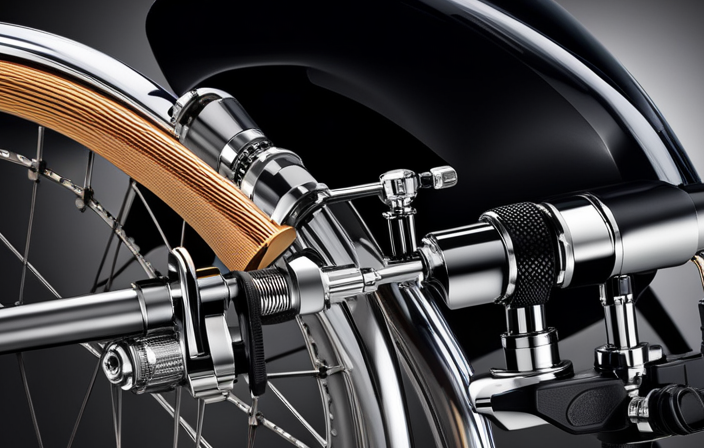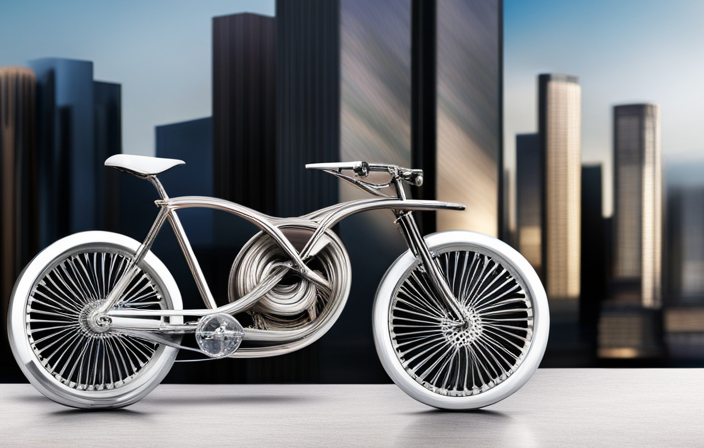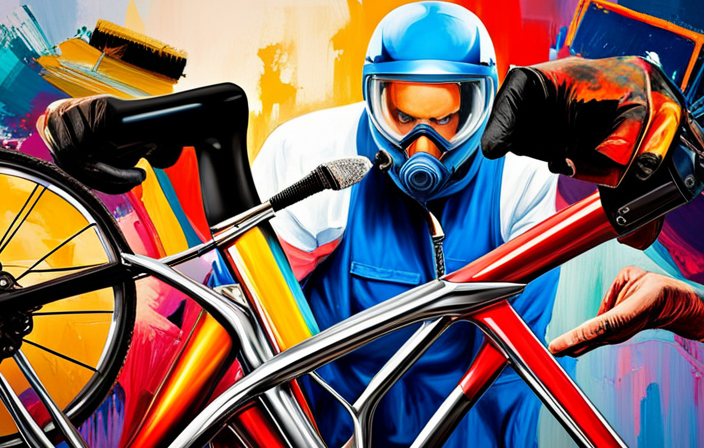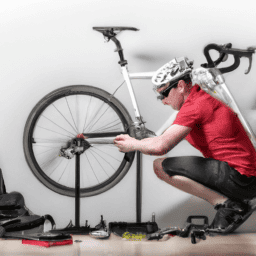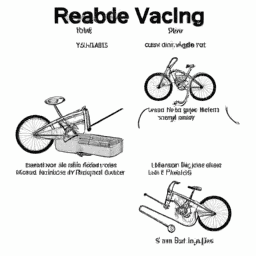Ever thought about how a basic bicycle pump is able to effortlessly inflate your bike tires? It’s an intriguing process that involves air pressure, mechanical parts, and a touch of physics.
In this article, I’ll unravel the mystery and take you through the inner workings of a bicycle pump. Get ready to dive into the world of valves, pistons, and pressure gauges as we explore how this essential tool keeps your tires properly inflated for smooth rides and efficient pedaling.
Key Takeaways
- Lubricating moving parts with silicone-based or oil-based lubricants is important for maintaining pump efficiency and lifespan.
- Regularly checking for leaks in valve or hose connections and promptly addressing them is necessary.
- Ensuring tight and secure connection between pump and valve, replacing faulty valves, and checking for obstructions in barrel or hose can help troubleshoot common issues.
- Using a bicycle pump can lead to improved performance, enhanced safety, longer tire lifespan, cost-effectiveness, and eco-friendliness compared to alternative methods of inflating bike tires.
Components of a Bicycle Pump
The components of a bicycle pump include a handle, a barrel, and a hose. The handle is used to provide leverage and make pumping easier. The barrel is where the air is compressed and stored. The hose connects the pump to the bike valve, allowing air to flow from the pump into the tire.
To understand the inflation process, it is important to know about the different types of bike valves. The most common types are the Presta valve and the Schrader valve. The Presta valve is slender and requires a small opening, while the Schrader valve is larger and resembles the valve on a car tire. Knowing which type of valve your bike has will help you choose the correct pump attachment.
Understanding air pressure is crucial for proper inflation. It determines how firm or soft your tires are. Maintaining the correct air pressure will ensure optimal performance and prevent tire damage.
Moving on to understanding air pressure…
Understanding Air Pressure
To understand air pressure, you need to grasp the concept of how it affects the inflation process of a bicycle tire. Air pressure plays a crucial role in the functionality of a bicycle pump. Here are four key points to pique your interest:
-
Practical applications of air pressure in everyday life: From inflating car tires to powering pneumatic tools, air pressure is used in various applications that make our lives easier.
-
The physics behind air compression in bicycle pumps: When you push the handle down, it compresses the air inside the pump cylinder, increasing its pressure. This high-pressure air is then forced into the tire, inflating it.
-
Understanding the relationship between pressure and volume: As the volume of the pump cylinder decreases, the pressure inside increases. This principle is known as Boyle’s law and is fundamental to the mechanics of a bicycle pump.
-
The importance of airtight seals: Bicycle pumps are designed with airtight seals to prevent any air from escaping during the inflation process, ensuring an efficient and effective pumping experience.
Now that you have a better understanding of air pressure, let’s move on to a step-by-step guide to using a bicycle pump.
Step-by-Step Guide to Using a Bicycle Pump
When using a bicycle pump, the first step is to attach the pump to the valve. This is done by aligning the pump head with the valve and securely fastening it.
Once attached, the next step is to start pumping the handle up and down in a smooth and controlled motion. This action will push air into the tire and increase the pressure.
After pumping for a few seconds, it is important to pause and check the tire pressure using a pressure gauge. This will ensure that the tire is properly inflated and ready for use.
Attach the Pump to the Valve
First, you’ll need to attach the pump to the valve on the bicycle tire. The attaching process may vary depending on the type of valve your bicycle has.
There are two common types of valves: the Schrader valve and the Presta valve. For a Schrader valve, simply unscrew the valve cap and press the pump head onto the valve until it fits snugly. Make sure it’s centered to avoid any air leakage.
On the other hand, for a Presta valve, unscrew the valve cap and remove the valve nut. Then, press the pump head onto the valve and tighten the nut to secure it in place.
Once the pump is securely attached, you can move on to the next step of pumping the handle, which will inflate the tire with air.
Pumping the Handle
Once the pump is securely attached, you can start pumping the handle to inflate the tire with air. When pumping, it is important to use the correct pumping technique to ensure efficient inflation. Here are three key points to keep in mind:
-
Grip the handle firmly: Hold the handle with a secure grip to maintain control and prevent slippage during the pumping process.
-
Use your body weight: To maximize the efficiency of each pump, use your body weight by leaning into the pump. This will help generate more force with each stroke and make the pumping process easier.
-
Take advantage of ergonomic design: Many modern bicycle pumps are designed with ergonomic features, such as a comfortable grip and a smooth pumping action. Utilize these design elements to make the pumping process more comfortable and less straining on your body.
With these pumping techniques and the help of ergonomic design, you can quickly and effectively inflate your tire.
Now, let’s move on to checking the tire pressure…
Checking the Tire Pressure
After pumping the handle vigorously, it’s time to check the tire pressure to ensure optimal performance and safety. This step is crucial as the right amount of air in your bicycle tires can greatly impact your riding experience.
It is essential to have proper tire pressure to prevent flats, improve traction, and enhance efficiency. While a bicycle pump is the most common tool used for this purpose, there are alternative tire inflators available, such as CO2 cartridges and electric pumps. These alternatives can be quicker and more convenient, especially for on-the-go riders. However, it is important to note that they may not provide as precise or consistent pressure as a traditional pump.
Therefore, it is always recommended to have a good quality pump on hand for regular checks and adjustments. Now, let’s delve into the different types of bicycle pumps that are available in the market.
Types of Bicycle Pumps
To understand the different types of bicycle pumps, you’ll need to know how they function and what features they offer. There are two main types of valve attachments used in bicycle pumps: the Presta valve and the Schrader valve. The Presta valve is commonly found on road bikes and requires a narrower pump attachment, while the Schrader valve is found on most mountain bikes and is similar to the valve used in car tires.
There are also two main categories of bicycle pumps: portable pumps and floor pumps. Portable pumps are smaller, lightweight, and easy to carry on rides. They are great for quick inflation and emergency situations. On the other hand, floor pumps are larger and more stable, designed to be used at home or in a workshop. They offer higher air volume and pressure, making them ideal for regular maintenance and precise tire inflation.
Understanding the different types of bicycle pumps is crucial for choosing the right one for your needs. For maintenance and care tips, it’s important to keep your pump clean, lubricate moving parts regularly, and store it in a dry place.
Maintenance and Care Tips
When it comes to maintaining and caring for your bicycle pump, there are a few key points to keep in mind.
First and foremost, regularly cleaning the pump is crucial to ensure its optimal performance.
Additionally, lubricating the moving parts of the pump will help to prevent any potential issues or malfunctions.
Lastly, it is important to regularly check for any leaks in the pump, as this can greatly affect its efficiency.
By following these maintenance and care tips, you can ensure that your bicycle pump remains in top-notch condition.
Cleaning the Pump
First, make sure to remove any dirt or debris from the pump. Cleaning the pump regularly is essential to ensure its proper functioning and prevent rust.
Here are some effective cleaning techniques to keep your bicycle pump in optimal condition:
- Use a soft cloth or brush to wipe away any dirt or dust.
- Dip a cloth in warm soapy water and clean the exterior of the pump.
- For stubborn stains, use a mild detergent or vinegar solution.
- Rinse the pump with clean water and dry thoroughly before storage.
By following these cleaning techniques, you can maintain the longevity of your bicycle pump and prevent any damage caused by rust or debris.
Now, let’s move on to the next section, where we will discuss lubricating the pump’s moving parts.
Lubricating Moving Parts
Now, let’s move on to how to properly lubricate the moving parts of your pump. Lubricating the moving parts is essential for maintaining the pump’s efficiency and prolonging its lifespan. There are various lubricant options available, such as silicone-based or oil-based lubricants. These lubricants help reduce friction between the moving parts, ensuring smooth operation and preventing wear and tear. Regular maintenance is crucial to ensure the pump functions optimally. It is recommended to lubricate the moving parts every few months or as needed, depending on the frequency of use. By doing so, you can prevent any potential issues and extend the life of your bicycle pump. Now, let’s move on to checking for leaks to ensure your pump is in top-notch condition.
Checking for Leaks
To ensure your pump is in good condition, it’s important to regularly check for any leaks. Repairing leaks is essential for maintaining the effectiveness of your bicycle pump. Leaks can occur in various parts of the pump, such as the valve or the hose connections. Inspect these areas carefully, looking for any signs of air escaping.
If you find a leak, it’s crucial to address it promptly. Depending on the severity of the leak, you may be able to fix it by tightening a loose connection or replacing a faulty valve. Preventing leaks is just as important as repairing them. By properly lubricating the moving parts, you can reduce the chances of leaks occurring.
In the next section, we will discuss troubleshooting common issues that may arise while using a bicycle pump.
Troubleshooting Common Issues
If your bicycle pump is not working properly, you can troubleshoot common issues to fix the problem.
One common issue is a leaky connection between the pump and the valve. To fix this, make sure the connection is tight and secure.
Another issue could be a faulty valve, which can be replaced easily.
Additionally, check for any obstructions in the pump’s barrel or hose, as these can prevent proper inflation.
Proper inflation techniques are also important to consider when troubleshooting. Make sure you are using the correct pressure gauge and following the recommended PSI for your bike tires.
By troubleshooting these common issues and using proper inflation techniques, you can ensure your bicycle pump is working efficiently.
This will allow you to enjoy the benefits of using a bicycle pump, such as convenience and cost savings.
Benefits of Using a Bicycle Pump
You can reap the benefits of using a bike pump by maintaining proper tire inflation. By keeping your bike tires adequately inflated, you can enjoy a smoother and more comfortable ride. Here are some advantages of using a bicycle pump:
-
Improved performance: Properly inflated tires provide better traction and reduce rolling resistance, allowing you to ride faster and with less effort.
-
Enhanced safety: Well-inflated tires offer better control and stability, reducing the risk of accidents or skidding.
-
Longer tire lifespan: Maintaining the correct tire pressure helps prevent excessive wear and tear, extending the life of your tires.
-
Time and cost-effective: With a bike pump at home, you can quickly and easily inflate your tires whenever needed, saving you time and money compared to visiting a bike shop.
-
Eco-friendly: Using a bike pump reduces the need for disposable CO2 cartridges or aerosol sealants, making it a more environmentally friendly option.
With these advantages in mind, let’s explore alternative methods of inflating bike tires.
Alternative Methods of Inflating Bike Tires
One alternative method for inflating bike tires is using a CO2 inflator. These portable compressors are small and lightweight, making them easy to carry on a ride. CO2 inflators work by using a small canister of compressed carbon dioxide gas to quickly fill the bike tire with air.
To use a CO2 inflator, you simply attach it to the tire valve, release the gas, and watch as the tire inflates in seconds. This method is particularly useful in emergency situations or when you need to quickly inflate a tire on the go. However, it is important to note that CO2 inflators do have limitations, such as the need to carry extra canisters and the potential for over-inflation.
Moving on to the environmental impact of these alternative methods…
Environmental Impact
Using a CO2 inflator to inflate bike tires has a potential environmental impact due to the use of compressed carbon dioxide gas. This can contribute to a higher carbon footprint, as the production and transportation of CO2 can release greenhouse gases into the atmosphere. However, there are sustainable alternatives that can help minimize this impact.
-
Manual pump: Using a manual bike pump powered by human energy is a more eco-friendly option. It requires no additional resources and reduces carbon emissions.
-
Electric pump: Opting for an electric pump that runs on renewable energy sources, such as solar power, can also help reduce environmental harm.
-
Portable air compressor: Investing in a portable air compressor that can be powered by a car’s cigarette lighter or a rechargeable battery offers convenience while minimizing carbon emissions.
Considering these sustainable alternatives, it is important to prioritize eco-friendly options when inflating bike tires. This ensures that we reduce our carbon footprint and contribute to a greener future.
Transitioning into the next section, it is crucial to weigh the pros and cons of each method to reach a well-rounded conclusion.
Conclusion and Final Thoughts
Now that we have explored the environmental impact of bicycle pumps, let’s conclude our discussion with some final thoughts.
As an expert in bike maintenance, I want to emphasize the importance of regular tire maintenance and the benefits it brings. While a bicycle pump is the most common method of inflating bike tires, there are alternative methods available as well.
One such method is using a CO2 inflator, which provides a quick and efficient way to inflate tires on the go.
Additionally, keeping your tires properly inflated not only enhances your riding experience but also improves your bike’s performance and safety. It reduces the risk of flats, improves traction, and ensures a smoother ride.
So, make it a habit to check your tire pressure regularly and invest in a good quality pump or inflator to keep your bike rolling smoothly.
Frequently Asked Questions
Can I use a bicycle pump to inflate other types of tires, such as those on a car or motorcycle?
Yes, you can use a bicycle pump to inflate other types of tires, like those on a car or motorcycle. However, it may take longer due to the different valve types and pressure requirements.
Is it possible to overinflate a bicycle tire using a pump?
Yes, it is possible to overinflate a bicycle tire using a pump. Overinflation risks include tire blowouts and decreased control. It’s crucial to maintain proper tire pressure for optimal performance and safety.
How long does it typically take to fully inflate a bicycle tire using a pump?
Typically, it takes me around 3-5 minutes to fully inflate a bicycle tire using a pump. The inflation speed can vary depending on the pump and the recommended pressure for the tire.
Are there any safety precautions I should take while using a bicycle pump?
When using a bicycle pump, it’s important to take safety precautions. Before starting, make sure the pump is in good maintenance and properly attached to the valve. This will ensure a safe and effective inflation process.
Can I use a bicycle pump to deflate a tire if it is overinflated?
Yes, you can use a bicycle pump to deflate a tire if it is overinflated. However, it is important to note that bicycle pumps are primarily designed for inflating tires. They can also be used for other purposes, such as inflating sports balls or inflatable toys. When using a bicycle pump for deflating, make sure to choose the right type of pump for your needs.
Conclusion
After learning about the inner workings of a bicycle pump, it is clear that this simple tool holds great power. Just like the air filling the tires, the bicycle pump symbolizes progress and movement.
It reminds us that with every push and pump, we can overcome any obstacle and reach new heights. So, let us embrace the humble bicycle pump as a symbol of determination and resilience.
Next time you ride your bike, remember the power of the pump and let it propel you forward on your journey.
